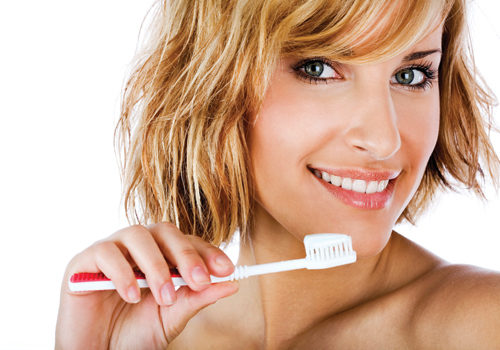Pick up a tube of toothpaste and read the label. If you find ingredients you can’t pronounce, take caution. While brushing is a healthy habit that contributes to one’s overall wellbeing, some ingredients found in traditional products may do more harm than good.
Two major offenders are sodium lauryl sulfate (SLS) and propylene glycol. SLS is a surfactant used in toothpastes to help create foam while brushing. While the thickening quality of SLS helps to spread the paste along teeth, it has also been linked to irritation in the mouth. Propylene glycol is a petrochemical that helps pastes retain water and maintain consistency throughout brushing. This substance, which is also found in the antifreeze in your car, can alter the skin and allow chemicals to penetrate into the body more easily.
Before putting down your toothbrush for good, know that there are natural alternatives to these two ingredients. Some oral health companies have recognized consumers’ concern and have integrated plant-based ingredients, such as vegetable glycerin, to provide the same effects in their pastes (1).
The Good News
Luckily, the natural products industry has begun exploring more alternatives to use in oral care, and you might be surprised by some of the items on this list.
• Baking soda, also known as sodium bicarbonate, can help whiten teeth and freshen breath. By neutralizing the pH in our mouths as well as volatile sulfur compounds, baking soda acts as a buffer to neutralize acids. It also dissolves into small spaces between teeth and act as a mild abrasive to remove stains (2).
• Cranberry contains proanthocyanidins (PACs), which may help inhibit plaque formation by preventing bacteria from attaching to the teeth (1).
• Green tea also works against the bacteria found in our mouths, and can fight inflammation (3).
• Neem bark, leaves, fruit, seeds and oils have all been noted for their medicinal qualities. Neem helps with oral care due to its abilities to help fight infection and regulate inflammation (4).
• Tea tree oil is another compound that helps defend the mouth from bacteria and infection (3).
• Xylitol is a naturally occurring carbohydrate that is derived from fibrous plant material. It is often used as a natural low-calorie/-carb sweetener because—unlike table sugar—the body absorbs and metabolizes xylitol slowly and it doesn’t cause large fluctuations in insulin levels. Xylitol aids in preventing tooth decay because the bacteria found in our mouths cannot digest it, and therefore do not release the acids that wear down enamel. With xylitol, bacteria won’t stick to teeth, the amount of acid-making bacteria is reduced (by up to 90%) and the mouth is left with a more neutral pH, which also creates an ideal environment for calcium and phosphate salts to move into weaker portions of enamel and begin to harden it (5, 6).
• Probiotics are somewhat new to the scene for oral care. Some strains of Streptococcus salivarius have data backing for supporting fresh breath and healthy teeth and gums. It populates the mouth with healthy bacteria strains, making the environment less suitable for other bacteria to thrive (7).
 The Fluoride Controversy
The Fluoride Controversy
For many years, fluoride has been at the center of a battle, with consumers torn between its benefits and risks. The American Dental Association endorses fluoride to prevent dental caries (the proper term for cavities) and tooth decay. Fluoride can be obtained through diet, in rinses, with professional treatments or in supplements; however the government found it was more cost effective to fluoridate public drinking water. This has caused some people to worry about any potential side effects of ingesting too much fluoride, such as the development of cancer, bone fractures and dental fluorosis. While there is very limited evidence to support a correlation between fluoride use and increased risk of cancer or bone fractures, studies show that having high exposure to fluoride during tooth development in childhood can lead to a greater chance of developing dental fluorosis. This condition can range from mild white marks on the teeth to more severe pitting and brown discoloration.
While shoppers may not be able to choose if fluoride is added to their water, stores can offer a choice of fluoride-free and fluoride-added toothpastes and leave the decision up to the consumer (8). WF
References
1. Burt’s Bees, www.burtsbees.com/natural-products/toothpaste, accessed Apr. 30, 2013.
2. Arm and Hammer, www.armandhammer.com.au/oral_care, accessed Apr. 30, 2013.
3. Kiss My Face, http://kissmyface.com/natural-oral-care, accessed Apr. 30, 2013.
4. Neem Foundation, www.neemfoundation.org, accessed Apr. 30, 2013.
5. Xylitol.org, www.xylitol.org/dental-info-about-xylitol, accessed Apr. 30, 2013.
6. Xlear, www.xlear.com, accessed Apr. 30, 2013.
7. Stratum Nutrition, www.stratumnutrition.com/Ingredients/BLIS-K12, accessed Apr. 30, 2013.
8. Department of Health and Human Services, “Review of Fluoride,” www.health.gov/environment/ReviewofFluoride/, accessed Apr. 30, 2013.
Shaina Fimbel is a freelance writer based in East Stroudsburg, PA.
Published in WholeFoods Magazine, December 2013









